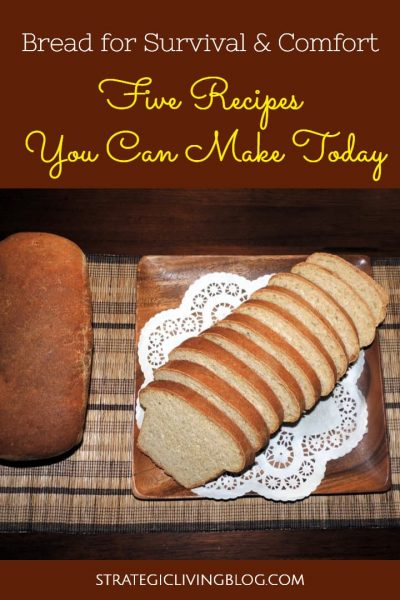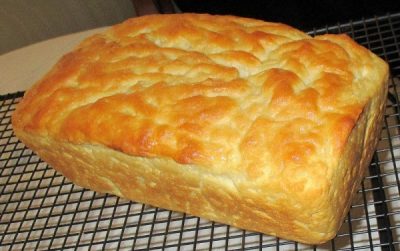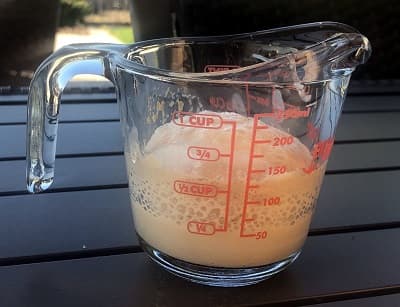Over the years, I have been a bread maker and bread eater. I have ground my own flour and hand-kneaded bread. I have also used an automatic bread machine where dump and go made homemade bread easy and quick. In between, I mastered creating a sourdough starter and making a no-knead dough in large buckets that could provide fresh bread for a two week period.
Making bread was something I did because I enjoyed the process and enjoyed the comfort it brought in knowing I was learning a powerful survival skill that could come in handy down the road.
So here we are today, in a SHTF situation that is putting us in survival mode. Bakers and non-bakers alike are starting to make bread while most of our country is in lock-down and we are advised to stay at home.
If you are like me, you have a lot of flour, wheat, salt and sugar in your survival pantry. In addition, you have a few pounds of yeast stashed away in your freezer so that it stays fresh and viable. We are the lucky ones because I have heard about major shortages that are frustrating some would-be bakers.
True confession: I have been making two loaves of low-carb bread a week since earlier this year. My bread has its beginnings in a mix from Bob’s Red Mill but to my consternation, the mix has been discontinued and I am seriously bummed. With low carb and Keto diets being so popular, I was hoping to share my recipe with you this week. Instead, I am going back to the kitchen so I can come up with a recipe that is not reliant on a commercial mix. Stay tuned for that.
So, for now, my pal Ron Brown (author of the Non-Electric Lighting Series) is stepping in with five simple bread recipes that are super good, super easy and tried and true. The best part is that two of the five do not require yeast.
Let’s get started.
Five Simple Bread Recipes
by Ron Brown
There are several ways to make bread using wheat flour. This article presents five ways, all with the emphasis on simple. The method you choose depends on your resources.
Most recipes call for yeast or baking powder. These are “leavening agents” — ingredients that cause a foaming action within the dough, leaving tiny bubbles in the finished product. But some breads do not employ a leavening agent. Roti — a bread from India — is a prime example. And most recipes assume you’ll bake your bread in an oven. But not all. Some breads are cooked on a griddle or frying pan on the stovetop.
And the third variable is the shape of the bread. Is it baked in a pan? Or patted into shape with your hands? Or rolled with a rolling pin? There are many ways to make a tasty, edible product.
My own introduction to bread-baking began when (about 1960) I came home from college on vacation and discovered my mother had started baking and selling bread in a local gourmet food store. She was selling 20 loaves a week. A couple of years later it was 250 loaves a week. In the beginning she used an old, hand-cranked bread mixer similar to the one pictured below. It clamped to the tabletop and was an antique even then.
As you might expect, I was immediately pressed into service. Both my father and myself were delighted when she could finally afford a proper commercial mixer. Point is, I learned more about bread-making than I ever wanted to know.
Let’s begin our discussion with roti, an Indian bread that is unleavened. The dough is rolled out with a rolling pin and cooked on top of the stove, no oven required.
Bread #1 ROTI
Ingredients:
2 cups whole wheat [brown] flour
½ teaspoon salt
¼ cup salad oil
¾ cup water
Directions:
1. Mix ingredients with a spoon, then knead by hand.
2. Let the dough rest for 5 minutes (in the refrigerator if possible; else at room temperature).
3. Break off ping-pong-ball sized pieces and dust them with flour. Roll out the pieces on a floured surface with a rolling pin to pie-crust thickness.
4. Fry on a griddle or frying pan (flipping once so that both sides are cooked).
5. If, as soon as the roti is cooked both sides, you place it over an open flame (briefly, using tongs), it will balloon up. Call it family fun.
I have close friends who hail from India and who fondly remember the daily roti ritual at breakfast — mother frying up the roti on a griddle; the family, from children to grandparents, circling the table awaiting their portion.
Before you stick up your nose at roti, please note the similarity between roti and pie crust. The only differences are that pie crust uses white flour instead of brown, semi-solid shortening instead of cooking oil, and is baked in an oven instead of fried on a griddle.
Bread #2 FLATBREAD
Next in the lineup is flatbread. It’s cooked on the stovetop (and so doesn’t require an oven) and is leavened with baking powder. Baking powder is a mixture of baking soda (that is, bicarbonate of soda) and cream of tartar. If you try using baking soda alone, rather than baking powder, you will end up with a bread that looks wonderful but tastes terrible. Trust me.
So here’s the flatbread recipe:
Ingredients:
2 cups flour
1 cup water
1 tablespoon baking powder
1 teaspoon salt
1 tablespoon of salad oil, butter or shortening
Directions:
1. Mix the dry ingredients together and stir in the water (until it has the consistency of tacky pizza dough); then knead by hand.
2. Let the dough rest (and rise) in a greased bowl for half an hour.
3. Divide the dough into 6 pieces. With a rolling pin, roll out each piece on a floured surface.
4. Heat griddle (until it goes pssst when touched with a moistened finger).
5. Grease the surface of the griddle (with a crumpled piece of waxed paper dabbed in some butter) and fry the dough on both sides until done (it will have brown spots on each side).
Note: The proper thickness of the rolled dough is hard to define. It should be thicker than pie crust but, when you fry the first side, it should bubble. If it doesn’t bubble, it’s likely too thick — meaning it will cook up a bit raw in the center. Practice makes perfect.
Here is the finished product:
Bread #3 FRENCH BREAD
French bread is baked in an oven, leavened with yeast, and shaped with your hands (not a pan).
Ingredients:
4 cups white flour
2 cups warm water (hot water will kill the yeast action)
1 packet of dry yeast (2¼ teaspoons)
2 teaspoons salt
1 teaspoon sugar (feeds the yeast; not for sweetness)
1 tablespoon of cooking oil (olive oil, canola oil, etc.)
Directions:
1. Put the water in a bowl. Sprinkle the yeast on top. Add the sugar, salt, and cooking oil. Stir.
2. Add half the flour and stir until the lumps are (mostly) gone.
3. Add the rest of the flour, ½ cup at a time. Knead the dough with your hands to produce a smooth, uniform, slightly sticky dough.
4. After kneading, let the dough rest in the bowl for 5 minutes.
6. Gather the dough into a log (not a ball) and place it on a greased cookie sheet. Let the dough “rise” for an hour in a warm place.
7. Preheat the oven to 375°F (190°C) while the bread is rising. Bake time is 45 minutes to one hour.
8. To test for being done, tap the loaf with your finger. When done, it gives a hollow, thumping sound.
9. Remove the bread from the oven and cool it on a wire rack (so that air circulates on all sides). If you don’t have a rack, lay the loaf upside down and flip it every 5 minutes while it cools (else the bottom will get soggy).

Bread #4 REGULAR HOMEMADE BREAD
This to me is “homemade bread” — what my mother made and sold. It’s leavened with yeast, cooked in a bread pan, baked in an oven.
Ingredients:
2½ to 3 cups of all-purpose white flour
1 cup warm water (hot water will kill the yeast action)
1 tablespoon dry yeast
1 teaspoon salt
1 teaspoon sugar
2 tablespoons cooking oil (melted butter or shortening will work but not as well as cooking oil)
Directions:
1. Put the water in a bowl. Sprinkle the yeast on top. Add the sugar, salt, and cooking oil. Stir.
2. Add half the flour and stir until the lumps are (mostly) gone.
3. Add the rest of the flour, ½ cup at a time. Knead the dough with your hands to produce a smooth, uniform, slightly sticky dough.
4. After kneading, let the dough rest in a greased bowl for 5 minutes.
5. Gather the dough into a log (not a ball) and place it in a greased bread pan. Let the dough “rise” in the bread pan in a warm place; one hour is typical.
6. While the bread is rising, preheat the oven to 425°F (220°C). Bake time is 20-25 minutes.
7. To test for being done, tap the loaf with your finger. When done, it gives a hollow, thumping sound.
8. Remove the bread from the oven and cool it on a wire rack (so that air circulates on all sides). If you don’t have a rack, lay the loaf on its side and flip it from one side to the other every 5 minutes while it cools (else the bottom will get soggy).
Note: Back at the kneading stage, if too little flour is added the bread won’t cook properly in the center (it will be raw in the center). If too much flour is added, the bread will be heavy or dry (but edible). Only experience will tell you the right amount of flour — that last tiny bit — that needs to be added.
Here is the finished loaf, fresh from the oven. Painting the warm crust with a touch of butter does agreeable things to the look, texture, and taste.
Bread #5 BREAD-MACHINE BREAD
Like many other people we know, my wife and I once bought a bread machine. The bread was delicious. We both started to gain weight. Hence, like many other people we know, we tucked the machine away in the pantry, never to be seen again. But, perhaps — given today’s COVID-19 lockdown — it’s time to dust it off.
Back in the day, this was our favorite recipe.
Ingredients:
1 cup less 2 tablespoons water
2 teaspoons butter or margarine
2 cups flour (1½ cups white “bread flour” and ½ cup brown whole wheat flour)
1 tablespoon sugar
2 teaspoons powdered, dry milk
1 teaspoon salt
1¼ teaspoon dry yeast
Directions:
1. Plug in the machine. It runs on 110-volt AC.
2. Place all ingredients in the bread pan in the order listed.
3. Push the button.

Bread #6 BEER BREAD
The title of this article is “Five Simple Bread Recipes” but here’s #6 as a bonus. I just now saw this on Facebook and have not yet tried it. It should work — given that beer contains yeast. It is yeast that causes bread to rise and beer to ferment.
Ingredients:
1 can of warm beer
3 cups of flour
¼ cup sugar
Directions: Mix. Bake at 350°F 40-60 minutes. Then (or so it says on Facebook), “Boom, you have bread!”
In honor of the coronavirus, probably Corona beer is the appropriate brand to use.
Ron’s Conclusion
Bread has been made for thousands of years by primitive people with crude utensils and less-than-perfect ingredients. If they can do it, so can you. But, like the lady says about making cheese, “I only have one recipe. I only need one. Because it always comes out different.” Bread is kind of like that, too.
I know lots of folks with ritzy houses and expensive kitchens and swanky pots and pans. Paying $600 for one teakettle is out of my league. But people do it. I’ve seen kitchens where the stove is, for all practical purposes, nothing more than a knick-knack cabinet to display corn-husk dolls and school projects.
But, now that you’re sheltering in place and you’re hungry, it’s time to actually use that stove. Please know that you cannot learn to bake bread by reading about it. It’s a hands-on activity, something you must actually do, up-close and personal.
Bon appétit.
Copyright © 2020 by Ron Brown
~~~~~
A Word About Yeast
I have heard from friends and neighbors that yeast is now in short supply. That is really a shame since when kept in the freezer, yeast will remain viable for a very long time. Want proof (pun intended)?
Today I set some of my “frozen” packaged yeast on the counter overnight. I then proofed my yeast by adding 1 teaspoon of sugar and 2 1/4 teaspoons of yeast (~ one envelope) to 1/4 cup of warm water. I gave it a good stir then set it aside for ten minutes. The mixture bubbled and smelled quite yeasty. An hour later, my bubbly yeast mixture reached close to the top of my measuring cup.
The lesson learned is that when the current emergency is over, stock up on yeast and store it in the freezer. Fortunately, yeast is quite compact so it will not take up much space in your freezer.
BOGO HIGH POTENCY FORMULAS
20% Off Everything Else Using Code GAYELEVY
Summing It All Up
Baking your own bread saves money. I have not run a precise calculation, but as far as I can tell, the cost is less than one dollar per loaf, depending on whether or not you purchase your ingredients in bulk or on sale. Not only that, homemade bread is healthier without chemical additives, unhealthy preservatives, and sugary sweeteners like high-fructose corn syrup. Add best of all, homemade bread tastes better.
Trust me. Once you get the hang of bread making, you will never go back to store-bought. And yes, in case you are interested, I will be checking back in on breadmaking once I master a decent low-carb bread recipe from scratch. Stay tuned because I can hear my inner chemist calling.
Yours for a Joyful Life,
Gaye
Strategic Haul
Ron Brown’s 8 Non-Electric Lighting Series: Today it is a pandemic but tomorrow it might be a long term lights out situation. Are you ready? Pick one or all of these books to learn how you can prepare for a time when electric lighting may not be available. Read about one of Ron’s book in The Relevance of Non-Electric Lighting: Interview with Ron Brown.
The New 2000-Hour Flashlight: The first edition of this book showed how to modify one flashlight, a specific Eveready model, such that it ran 2000 hours on one battery. That book was republished when Eveready discontinued the flashlight. This edition shows how to obtain extended run times using other brands, one of which runs 2200 hours, better than the original. (Incidentally, 2200 hours equates to three months of continuous running, night and day.)
Gaye’s Bread Machine: I own two bread machines. One is a compact Oster and the other is a Cuisinart CBK-100. Both make perfect bread. This issue I have is that current prices from these machines are over the top. If you need a bread machine, check eBay or when it is safe to venture out, Goodwill or another thrift store. I paid no more than $100 for my ABMs. Current prices are close to $300 which is a travesty!
Artisan Bread in Five: This book will change the way you make bread. The way it works is that you mix up a tub of dough that is refrigerated until you need it. You take out a grapefruit-sized ball of the pre-made dough, dust it with flour, shape, and bake, No kneading required. Warning: eating this bread is habit-forming and may contribute to an expanding waistline.
Bamboo Bread Cutter for Homemade Bread: If you have struggled with slicing bread into nice, even slices, you will love this bamboo slicer. Depending on where you place the divider panel, you can vary the width of the slices. I added blue tape to mark the “medium” width that I prefer. You will love this slicer!
~~~~
Like this? Be sure to visit Strategic Living on Facebook and Pinterest! To learn more about Gaye, visit her ABOUT page.
Want to give CBD Oil a try? Get a 20% discount using code "gayelevy" at checkout. Free shipping on orders over $100 and a 60 day return policy.
















Hello, Thanks for sharing these bread recipes -I’m always looking for easy bread recipes. I do have a question about Recipe #5 Bread Machine Bread: Can you substitute regular whole milk for the 2 teaspoons powdered, dry milk?
Thanks!
Milk improves the crumb/texture of bread and adds richness. I would suggest adding half milk and half water, omitting the powdered milk completely if you do so.
I do something similar with my low-carb bread although I use half and half instead of milk.
Good to see you here, Bernie!
I’ll try that Gaye, I’ve got half and half as well, may use that with water. Thanks for the ideas!
I have not tried this so cannot give a foolproof answer. I suspect that if you add liquid milk then you should reduce the water by a like amount (else the dough might be too sticky). The only way to know for certain is to try it. Let us know how it works, OK?
Hi Ron, I will try it, and when I do, I’ll post it on the blog and link to this article!
Nice article. Ron Brown is my father, and I didn’t know he was writing this. I have worked in pizzerias for many years making handmade bread and dough, as well as years of experience with many kinds of yeast making homemade beer, mead, and other fermented drinks. Didn’t realize the family history. On the topic, I don’t recommend adding the salt to the yeast mixture. Salt kills yeast, makes it harder to proof. You can actually use much less yeast (half) if you let it set 10-15 minutes before adding the flour so it can eat the sugars and multiply. Same as Ron Brown proved with the frozen yeast experiment. Stir the salt into the flour instead, so it gets added with the dry ingredients. And try warm milk (less than 110 degrees, too hot kills yeast) instead of water. No sugar needed in this case. Final tip, weight the flour, don’t measure. Everyone measures flour wrong.
Very nice to meet you, David Brown. I was the one that tested the frozen yeast by the way. And I agree, weighing is best. That is what I do when I make soap and it becomes a habit after awhile.
Gaye
Thanks Dave. I just Googled “How much does a cup of flour weigh?” and came up with the following. One cup of flour (be it white, all-purpose flour OR bread flour OR whole-wheat, brown flour) weighs 4.5 ounces. That equates to 128 grams.
Of course, by kneading the dough with your hands and thumping the loaf to see if it’s done you can do away with the need for cups and scales and thermometers altogether. You begin to know what it feels like, what it looks like, what it smells like. It just takes a few years of experience, LOL.